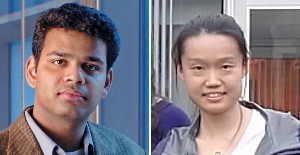
Our understanding of quantum physics has involved the creation of a wide range of “quasiparticles.” These notional constructs describe emergent phenomena that appear to have the properties of multiple other particles mixed together.
An exciton, for example, is a quasiparticle that acts like an electron bound to an electron hole, or the empty space in a semiconducting material where an electron could be. A step further, an exciton-polariton combines the properties of an exciton with that of a photon, making it behave like a combination of matter and light. Achieving and actively controlling the right mixture of these properties — such as their mass, speed, direction of motion, and capability to strongly interact with one another — is the key to applying quantum phenomena to technology, like computers.
Now, researchers at the University of Pennsylvania’s School of Engineering and Applied Science are the first to create an even more exotic form of the exciton-polariton, one which has a defined quantum spin that is locked to its direction of motion. Depending on the direction of their spin, these helical topological exciton-polaritons move in opposite directions along the surface of an equally specialized type of topological insulator.
In a study published in the journal Science, they have demonstrated this phenomenon at temperatures much warmer than the near-absolute-zero usually required to maintain this sort of quantum phenomenon. The ability to route these quasiparticles based on their spin in more user-friendly conditions, and an environment where they do not back-scatter, opens up the possibility of using them to transmit information or perform computations at unprecedented speeds.

The study was led by Ritesh Agarwal, professor in the Department of Materials Science and Engineering, and Wenjing Liu, a postdoctoral researcher in his lab. They collaborated with researchers from Hunan University and George Washington University.
The study also demonstrates a new type of topological insulators, a class of material developed at Penn by Charles Kane and Eugene Mele that has a conductive surface and an insulating core. Topological insulators are prized for their ability to propagate electrons at their surface without scattering them, and the same idea can be extended to quasiparticles such as photons or polaritons.
“Replacing electrons with photons would make for even faster computers and other technologies, but photons are very hard to modulate, route or switch. They cannot be transported around sharp turns and leak out of the waveguide,” Agarwal says. “This is where topological exciton-polaritons can be useful, but that means we need to make new types of topological insulators that can work with polaritons. If we could make this type of quantum material, we could route exciton-polaritons along certain channels without any scattering, as well as modulate or switch them via externally applied electric fields or by slight changes in temperature.”
Agarwal’s group has created several types of photonic topological insulators in the past. While the first “chiral” polariton topological insulator was reported by a group in Europe, it worked at extremely low temperatures while requiring strong magnetic fields The missing piece, and distinction between “chiral” and “helical” in this case, was the ability to control the direction of flow via the quasiparticles’ spin.
“To create this phase, we used an atomically thin semiconductor, tungsten disulfide, which forms very tightly bound excitons, and coupled it strongly to a properly designed photonic crystal via symmetry engineering. This induced nontrivial topology to the resulting polaritons,” Agarwal says. “At the interface between photonic crystals with different topology, we demonstrated the generation of helical topological polaritons that did not scatter at sharp corners or defects, as well as spin-dependent transport.”
Agarwal and his colleagues conducted the study at 200K, or roughly -100F without the need for applying any magnetic fields. While that seems cold, it is considerably warmer — and easier to achieve — than similar systems that operate at 4K, or roughly -450F.
They are confident that further research and improved fabrication techniques for their semiconductor material will easily allow their design to operate at room temperature.
“From an academic point of view, 200K is already almost room temperature, so small advances in material purity could easily push it to working in ambient conditions,” says Agarwal. “Atomically thin, ‘2D’ materials form very strong excitons that survive room temperature and beyond, so we think we need only small modifications to how our materials are assembled.”
Agarwal’s group is now working on studying how topological polaritons interact with one another, which would bring them a step closer to using them in practical photonic devices.
Agarwal group members Zhurun Ji, Yuhui Wang, Gaurav Modi and Minsoo Hwang; Hunan University’s Biyuan Zheng and Anlian Pan; and George Washington University’s Volker J. Sorger also contributed to the study.
The research was supported by the US Army Research Office under grant #W911NF-16-2-0194, the US Office of Naval Research under MURI grant# N00014-17-1-2661, and the US National Science Foundation under grants NSF-QII-TAQS (#1936276), NSF 2-DARE (EFMA-1542879) and a seed grant from Penn’s Materials Research Science and Engineering Center, which is supported by NSF grant DMR-1720530. Device fabrication work was carried out at the Singh Center for Nanotechnology at the University of Pennsylvania, which is supported by the NSF National Nanotechnology Coordinated Infrastructure Program under grant NNCI-1542153. Co-author Anlian Pan is supported by the National Natural Science Foundation of China (Nos. U19A2090, 51525202).
